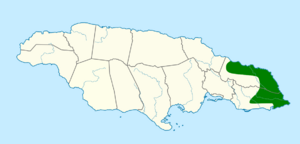Black-billed streamertail facts for kids
Quick facts for kids Black-billed streamertail |
|
|---|---|
 |
|
| Male | |
| Conservation status | |
| Scientific classification | |
 |
|
| Synonyms | |
|
Trochilus polytmus scitulus |
The black-billed streamertail (Trochilus scitulus) is a type of hummingbird found only in eastern Jamaica. It's known for the male's very long tail feathers, which look like streamers! This tiny bird is part of a group called "emeralds."
Contents
About the Black-billed Streamertail
Scientists often group animals based on how they are related. For the black-billed streamertail, some bird experts think it's a completely separate species. Others believe it's a subspecies, meaning it's a special kind of the "streamertail" bird. Interestingly, these two types of streamertails can even have babies together where their homes meet!
What Does the Black-billed Streamertail Look Like?
The male black-billed streamertail is quite striking. It measures about 22 to 24 centimeters (that's about 9 inches) long. A big part of this length comes from its amazing tail streamers, which can be 10 to 13 centimeters long! Males weigh around 4 to 5.8 grams, which is less than a quarter of an ounce.
Both male and female birds have a black beak. The male has a dark, velvety black head and neck. The rest of its top feathers are a bright green, like grass. Its long tail feathers are black with a shiny green color.
The female is smaller, about 10.5 centimeters (4 inches) long, and weighs 3.5 to 5.5 grams. She doesn't have the long tail streamers like the male. Her top feathers are a shiny bronze-green. Her belly is white with green spots on her chest and sides. Young males look like adult females but don't have the long tail streamers yet.
Where Do They Live?
The black-billed streamertail lives only in the far eastern part of Jamaica. Its home slightly overlaps with its close relative, the red-billed streamertail, which lives in other parts of the island.
These hummingbirds like to live in different kinds of forests. You can find them in green mountain forests, lowland tropical forests, and even forests that are growing back after being cut down. They don't like swampy areas or very dry, high places. You can spot them from sea level all the way up to 1500 meters (about 4900 feet) high. They are quite common in lower areas and even more common higher up.
How Do They Behave?
Moving Around
The black-billed streamertail is what we call an "elevational migrant." This means it moves up and down mountains depending on the time of year. They might go to lower areas when it's colder or food is scarce, and then move higher up when conditions are better.
What Do They Eat?
These hummingbirds love to drink nectar from many different kinds of flowers. They especially like a plant called Besleria lutea. They can find food at any height, from flowers close to the ground to those high up in the trees.
Sometimes, they even "steal" nectar! They might drink from holes in flowers that other birds, like bananaquits, have made. They also visit sap wells drilled by yellow-bellied sapsuckers. Besides nectar, they also eat tiny insects. They catch insects while hovering in the air or pick them off leaves and spiderwebs.
Raising a Family
Both male and female black-billed streamertails are very protective of their space. They will bravely defend their territory from other birds. When a female enters a male's territory, he will try to impress her. The male and female will fly back and forth. Then, the male flies up and down in front of the female, showing off his long tail streamers.
These birds can have babies at any time of the year, but they mostly breed between January and May. They might even raise three groups of babies in one year! The nest is shaped like a cup and is made of soft plant fibers held together with spiderweb. They often decorate the outside with lichen. Nests are usually built on a thin branch about 1 to 3 meters (3 to 10 feet) above the ground. The female sits on two eggs for 17 to 19 days. The baby birds are ready to fly out of the nest about 19 to 24 days after they hatch.
Sounds They Make
The black-billed streamertail makes several interesting sounds. Their calls include a loud, metallic ting or teet. They also make a longer twink-twink-twink sound that gets lower in pitch at the end.
When adult males fly, they make a special whirring sound. This sound happens with each flap of their wings. Videos show that a specific feather on their wing (called primary feather eight) bends with each downstroke. This bending creates a small gap, which makes the fluttering sound you hear!
How Are They Doing?
The IUCN (International Union for Conservation of Nature) has looked at the black-billed streamertail and says it is a species of "Least Concern." This means they are not currently in danger of disappearing. Even though they live in a small area and we don't know exactly how many there are, or if their numbers are growing or shrinking, there are no big threats right now. They seem to be able to live in places changed by humans, which is good news for their future.


